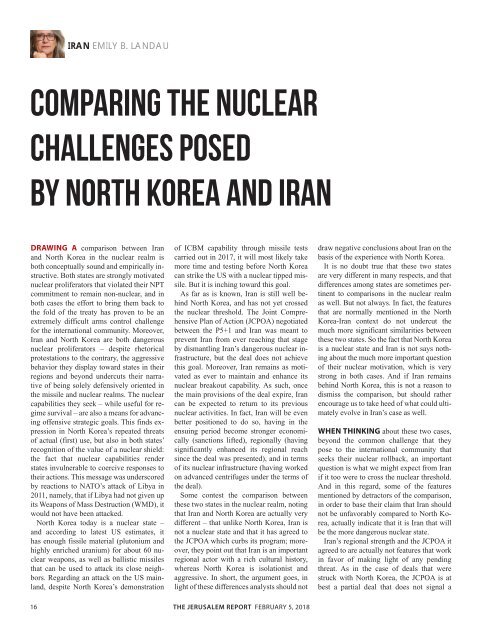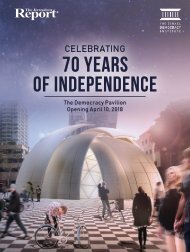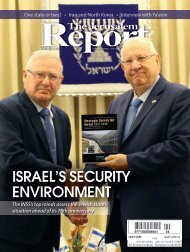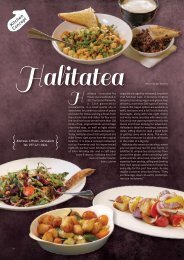All small
You also want an ePaper? Increase the reach of your titles
YUMPU automatically turns print PDFs into web optimized ePapers that Google loves.
IRAN EMILY B. LANDAU<br />
Comparing the nuclear<br />
challenges posed<br />
by North Korea and Iran<br />
DRAWING A comparison between Iran<br />
and North Korea in the nuclear realm is<br />
both conceptually sound and empirically instructive.<br />
Both states are strongly motivated<br />
nuclear proliferators that violated their NPT<br />
commitment to remain non-nuclear, and in<br />
both cases the effort to bring them back to<br />
the fold of the treaty has proven to be an<br />
extremely difficult arms control challenge<br />
for the international community. Moreover,<br />
Iran and North Korea are both dangerous<br />
nuclear proliferators – despite rhetorical<br />
protestations to the contrary, the aggressive<br />
behavior they display toward states in their<br />
regions and beyond undercuts their narrative<br />
of being solely defensively oriented in<br />
the missile and nuclear realms. The nuclear<br />
capabilities they seek – while useful for regime<br />
survival – are also a means for advancing<br />
offensive strategic goals. This finds expression<br />
in North Korea’s repeated threats<br />
of actual (first) use, but also in both states’<br />
recognition of the value of a nuclear shield:<br />
the fact that nuclear capabilities render<br />
states invulnerable to coercive responses to<br />
their actions. This message was underscored<br />
by reactions to NATO’s attack of Libya in<br />
2011, namely, that if Libya had not given up<br />
its Weapons of Mass Destruction (WMD), it<br />
would not have been attacked.<br />
North Korea today is a nuclear state –<br />
and according to latest US estimates, it<br />
has enough fissile material (plutonium and<br />
highly enriched uranium) for about 60 nuclear<br />
weapons, as well as ballistic missiles<br />
that can be used to attack its close neighbors.<br />
Regarding an attack on the US mainland,<br />
despite North Korea’s demonstration<br />
of ICBM capability through missile tests<br />
carried out in 2017, it will most likely take<br />
more time and testing before North Korea<br />
can strike the US with a nuclear tipped missile.<br />
But it is inching toward this goal.<br />
As far as is known, Iran is still well behind<br />
North Korea, and has not yet crossed<br />
the nuclear threshold. The Joint Comprehensive<br />
Plan of Action (JCPOA) negotiated<br />
between the P5+1 and Iran was meant to<br />
prevent Iran from ever reaching that stage<br />
by dismantling Iran’s dangerous nuclear infrastructure,<br />
but the deal does not achieve<br />
this goal. Moreover, Iran remains as motivated<br />
as ever to maintain and enhance its<br />
nuclear breakout capability. As such, once<br />
the main provisions of the deal expire, Iran<br />
can be expected to return to its previous<br />
nuclear activities. In fact, Iran will be even<br />
better positioned to do so, having in the<br />
ensuing period become stronger economically<br />
(sanctions lifted), regionally (having<br />
significantly enhanced its regional reach<br />
since the deal was presented), and in terms<br />
of its nuclear infrastructure (having worked<br />
on advanced centrifuges under the terms of<br />
the deal).<br />
Some contest the comparison between<br />
these two states in the nuclear realm, noting<br />
that Iran and North Korea are actually very<br />
different – that unlike North Korea, Iran is<br />
not a nuclear state and that it has agreed to<br />
the JCPOA which curbs its program; moreover,<br />
they point out that Iran is an important<br />
regional actor with a rich cultural history,<br />
whereas North Korea is isolationist and<br />
aggressive. In short, the argument goes, in<br />
light of these differences analysts should not<br />
draw negative conclusions about Iran on the<br />
basis of the experience with North Korea.<br />
It is no doubt true that these two states<br />
are very different in many respects, and that<br />
differences among states are sometimes pertinent<br />
to comparisons in the nuclear realm<br />
as well. But not always. In fact, the features<br />
that are normally mentioned in the North<br />
Korea-Iran context do not undercut the<br />
much more significant similarities between<br />
these two states. So the fact that North Korea<br />
is a nuclear state and Iran is not says nothing<br />
about the much more important question<br />
of their nuclear motivation, which is very<br />
strong in both cases. And if Iran remains<br />
behind North Korea, this is not a reason to<br />
dismiss the comparison, but should rather<br />
encourage us to take heed of what could ultimately<br />
evolve in Iran’s case as well.<br />
WHEN THINKING about these two cases,<br />
beyond the common challenge that they<br />
pose to the international community that<br />
seeks their nuclear rollback, an important<br />
question is what we might expect from Iran<br />
if it too were to cross the nuclear threshold.<br />
And in this regard, some of the features<br />
mentioned by detractors of the comparison,<br />
in order to base their claim that Iran should<br />
not be unfavorably compared to North Korea,<br />
actually indicate that it is Iran that will<br />
be the more dangerous nuclear state.<br />
Iran’s regional strength and the JCPOA it<br />
agreed to are actually not features that work<br />
in favor of making light of any pending<br />
threat. As in the case of deals that were<br />
struck with North Korea, the JCPOA is at<br />
best a partial deal that does not signal a<br />
16<br />
THE JERUSALEM REPORT FEBRUARY 5, 2018
















